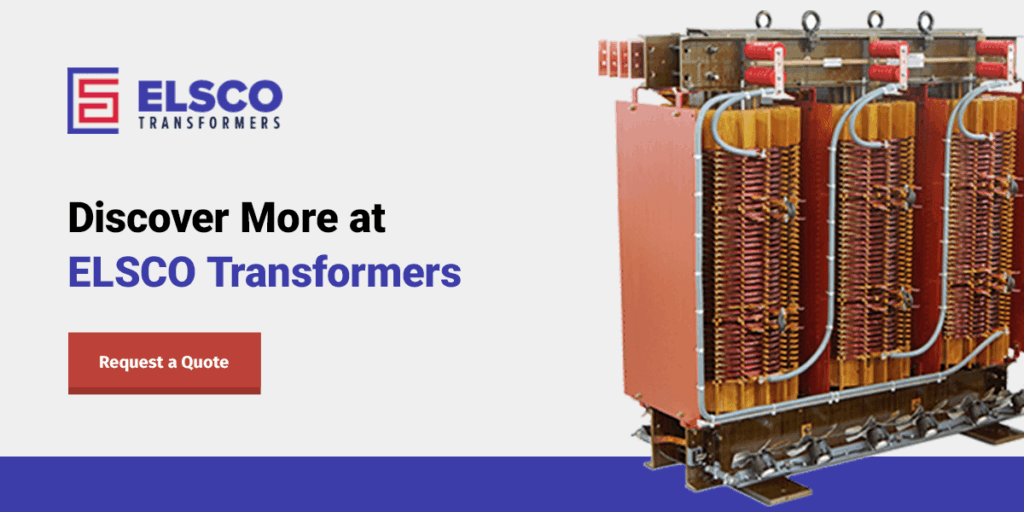- by Todd Benadum
- April 21, 2025
- Dry Type Transformers, Transformer Build Process
Transformers are electromagnetic devices that change the voltage levels in a circuit. Most dry type transformers contain primary and secondary windings around a magnetic steel core. Power from the incoming voltage source flows through the primary winding, while the secondary winding converts the energy and transmits it to the load. The core supports the windings and creates a magnetic field to increase or decrease the voltage levels.
Because transformers use electricity, they generate heat as waste during operation. This heat increases the unit’s temperature, shortening its lifespan and reducing efficiency. Since energy efficiency is critical in many of today’s power applications, choosing a transformer that meets the temperature requirements for a specific application is vital.
What Does Transformer Temperature Rise Mean?
Although many dry type transformers feature designs that can last several decades, constant exposure to temperatures above the unit’s tolerable limit can result in quick degradation of the insulation and a much shorter lifespan. Low-efficiency transformers typically generate more heat, resulting in a higher temperature rise — also referred to as C-rise. Generally, the higher a transformer’s efficiency and performance, the lower its C-rise.
C-rise is the average temperature increase in Celsius of a transformer over the ambient temperature when the unit is fully loaded. The heat rise occurs because of the power loss in the core and conductors. The transformer’s insulation system determines the maximum temperature the unit can withstand to maintain its operational efficiency.
Efficient transformers with low C-rise ratings are ideal for applications requiring long-term reliability and optimal performance.
Factors that can affect a transformer’s operating temperatures include:
- Insulation: Different insulation types can dissipate and transfer heat at different rates, dictating the C-rise levels a transformer can handle.
- Windings: The best transformer winding material depends on the specific application. Copper windings are more conductive and optimized for lower current density, while aluminum windings are more cost-effective for lower-voltage operations. Various winding techniques can also help reduce a transformer’s C-rise.
- Load: Choosing a transformer with a rating capable of handling a specific application is vital. Transformers are rated in volt-amperes (VA). The ratings provide information about the unit’s size and ability to supply a particular amount of power to a load.
- Installation location: Installing a transformer in an area with adequate airflow is crucial. Enclosed units with air vents should not be near walls or equipment that can obstruct airflow.
How Temperature Impacts a Transformer’s Lifespan
A transformer’s operating temperature determines how long it will remain in service. Simply put, cooler transformers last longer — lower operating temperatures preserve the integrity of the insulation over longer periods.
Heat can damage a transformer in several ways:
- Heat gradually breaks down the insulation at the molecular level. Over time, this degradation reduces the insulation’s ability to prevent electrical faults and short circuits.
- Daily temperature fluctuations cause materials to expand and contract repeatedly. This ongoing cycle creates mechanical stress on connections and components, which leads to increased resistance and localized hot spots.
- Higher temperatures speed up oxidation and corrosion of the insulation and conductors, especially when moisture is present.
The difference between choosing a lower or higher C-rise transformer is significant for long-term reliability. While both may use the same high-quality insulation rated for 200 degrees Celsius, the cooler-running transformer will experience much less thermal stress. That’s why ELSCO Transformers’ 80-degree C-rise transformers typically deliver decades of additional service compared to higher-temperature alternatives, even when built with identical materials.
Different Degree C-Rise Options for Dry Type Transformers
ELSCO Transformers offers dry type units in three C-rise temperature ratings, including:
- 80 degrees Celsius
- 115 degrees Celsius
- 150 degrees Celsius
These values are based on maximum ambient temperatures of 40 degrees Celsius. 80-degree C-rise transformers typically last the longest because they run the coolest.
ELSCO Transformers uses the highest class of insulation that can operate in temperatures up to 200 degrees Celsius. Our insulation can handle all three C-rise variations and offers increased flame resistance, impact strength and track resistance over other insulation types. We also use copper windings for all our transformers because they improve circuit strength, offer superior durability and outperform aluminum in all temperatures.
Benefits of Lower C-Rise Temperature Ratings
Lower C-rise transformers offer many advantages over options that are less expensive, including:
- Decreased cooling costs: A transformer with a lower C-rise rating generates less heat, reducing the need for additional cooling methods.
- Lower maintenance requirements: Cooler-running transformers experience less mechanical stress, expansion and contraction, leading to less maintenance and reduced parts replacement.
- Extended service life: Standard transformers often require replacement after 15 to 20 years, while ELSCO Transformers’ dry type units frequently remain in service for 30-plus years. This extended lifespan eliminates an entire replacement cycle for many applications.
- Reduced cost of ownership: Although the initial price is higher, the longer lifespans and reduced maintenance justify the investment. The long-term value becomes clear when you add up the savings over decades of service.
- Enhanced reliability: The improved performance and reduced failure rate of lower C-rise units decrease production downtime, which is especially critical in applications where uninterrupted power is crucial.
Discover More at ELSCO Transformers
At ELSCO Transformers, we’re committed to delivering products with the most efficient performance, quiet operation and easy installation. Our knowledgeable and experienced team can walk you through all the options to choose the best solution for your application. Besides offering a comprehensive catalog of medium-voltage dry type transformers in stock, we can customize a unit according to your specifications.
Call us at 800-232-9002 for more information or complete our online quote form to request pricing.


